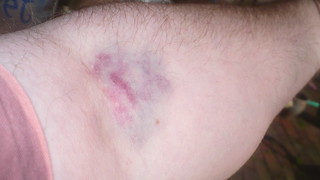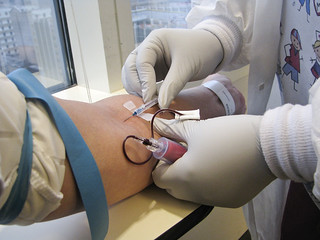By Rick Fromme
This edition of our ongoing medical device series,
“Fascinating Captain!” indeed runs the gamut. From an innovative type of
biomaterial that acts as internal “scaffolding” to assist internal tissues, to
a remote-controlled exoskeleton that can help paraplegics better ambulate
themselves, to non-wearable wearable technology, one thing is clear: the breadth
and scope advances in medical device technology continues to be far reaching,
with life-changing implications for many.
 A Peep into Your Sleep (a.k.a., An App for Your Nap)
A Peep into Your Sleep (a.k.a., An App for Your Nap)
Misfit Wearables, a company known for its aesthetically
pleasing wearable, Shine, is now collaborating with Beddit, a Finnish sleep
analysis company. The move pairs Beddit’s thin, unobstrusive sleep monitor,
which fits under a mattress, with Misfit’s tracking app for iOS and Android
networks.
It presents a logical option for Misfit Wearable users who
don’t necessarily want to wear their tracking device to bed, but still wish to
gather insights on their sleep patterns. Furthermore, Beddit’s under-the-bed sleep
monitor offers deeper analysis than what's was available when just using Shine.
The new device partnership analyzes heart beat, respiration and movement, which
then wirelessly transmits the data through Misfit’s app via Bluetooth.
Misfit's partnership with Beddit adds integration with its existing
fitness app and Shine fitness tracker, plus new algorithms to work with Beddit.
It also provides a way for Beddit, which has targeted hospitals and sleep
clinics, to have a stronger reach into the consumer market, a campaign it
started last year.
The “non-wearable” wearable also offers another way for
Misfit to set itself apart from other wearable companies.
This is Misfit's second move to expand its landscape of
connected devices in several weeks, after adding a Pebble app for fitness
tracking this past June.
Chip Off the Old Pill
 A remote controlled birth control device may be available
for consumers within the next four years. Created by MicroCHIPS, a Massachusetts-based drug delivery
implant developer, the chip will be inserted under a woman’s skin and can be
activated and deactivated by remote control. It works by administering a
low dose of the hormone levonorgestrel once a day.
A remote controlled birth control device may be available
for consumers within the next four years. Created by MicroCHIPS, a Massachusetts-based drug delivery
implant developer, the chip will be inserted under a woman’s skin and can be
activated and deactivated by remote control. It works by administering a
low dose of the hormone levonorgestrel once a day.
The chip emits the 30 microgram dose of levonorgestrel,
which is administered via an electric charge, powered by an internal battery,
which causes a seal around the hormone to melt and allows it to be
released into the body.The chip will last for approximately 16 years; then the user simply visits her doctor’s office for a replacement.
Remote control operation is wireless but is designed to be
tamper-proof. That is, someone wouldn’t be able to turn off the birth control
from across a room. Rather, the remote must be practically touching the skin to
work. All communications between the remote and the chip are encrypted, too.
The project is backed by the Bill & Melinda Gates
Foundation, which funds innovative health projects. It also funded a campaign
in 2012 to improve contraception access in developing countries.
 Reading the Body from Head to Toe from Your Bottom
Reading the Body from Head to Toe from Your Bottom
EarlySense, based in Waltham, MA, is now releasing a new
FDA-cleared Chair Sensor that gleams the heart rate, respiratory rate, and
motion from the patient’s buttocks. This is the first contact-free sensor for assessing
vital signs from a chair.
The sensor, which looks like boxy pillow, is placed on the
seat of a chair. A nearby monitor hooked up to the sensor displays and tracks
patient’s’ vitals in real time, passing on the readings to the nursing station.
In addition to raising alarms when the heart or breathing rates are abnormal,
the technology also warns clinicians when a patient is trying to get up from
the chair, which ensures someone can assist at a moment’s notice.
Clinicians have long known that ambulating patients from bed
to chair improves healing, reduces the risk of complications, and shortens
length of stay. Being positioned in an upright position appears to be of most
benefit in the early post-operative period by improving lung function and
reducing potential pulmonary complications. But to date, there wasn’t an
automatic, contact-free solution for keeping patients safe in their chairs
while being to assess key physiological vital signs.
The EarlySense Chair Sensor is a tool that empowers clinical
staff to provide proactive, effective, timely interventions when patients are
deteriorating or at risk of falling, therefore, accelerating recuperation and
reducing risks.
 Remote-Controlled Exoskeleton Helps Ambulate Spinal Cord Injury Patients
Remote-Controlled Exoskeleton Helps Ambulate Spinal Cord Injury Patients
The FDA has approved marketing of the first motorized
device intended to act as an exoskeleton for people with lower body paralysis
(paraplegia) due to a spinal cord injury. ReWalk, created in Israel, is a remote-controlled, “exoskeleton, motorized device worn over
the legs and part of the upper body that helps an individual sit, stand, and
walk with assistance from a trained companion, such as a spouse or home health
aide.
According to the U.S. Centers for Disease Control and
Prevention, there are approximately 200,000 people in the U.S. living with a spinal
cord injury, many of whom have complete or partial paraplegia.
ReWalk consists of a fitted, metal brace that supports the
legs and part of the upper body; motors that supply movement at the hips,
knees, and ankles; a tilt sensor; and a backpack that contains the computer and
power supply. Crutches provide the user with additional stability when walking,
standing, and rising up from a chair. Using a wrist-worn, wireless remote
control, the user commands ReWalk to stand up, sit down or walk.
ReWalk is for people with paraplegia due to spinal cord
injuries at levels T7 (seventh thoracic vertebra) to L5 (fifth lumbar vertebra)
when accompanied by a specially trained caregiver. It’s also for people with
spinal cord injuries at levels T4 (fourth thoracic vertebra) to T6 (sixth
thoracic vertebra) where the device is limited to use in rehabilitation
institutions. The device is not intended for sports or climbing stairs.
The FDA is requiring Argo Medical Technologies, Inc. to
complete a post-market clinical study that will consist of a registry to
collect data on possible adverse events related to the use of the ReWalk device,
as well as to prospectively and systematically assess the adequacy of its
training program.
Doctor’s Gotta’ Brand New Bag
 The once-iconic doctor’s bag has lost much of its luster within
the past few years as technologies available in health care facilities have
made a lot of what’s inside relatively less useful. Yet, mobile technology is rapidly
catching up, presenting today’s and tomorrow’s doctors with advanced diagnostic
and medical tools that make doctor’s bags – once a quaint image from the past –
a high tech marvel. Medgadget editor Shiv Gaglani shows off three recentlyreleased devices that are taking the doctor’s bag into the 21st century.
The once-iconic doctor’s bag has lost much of its luster within
the past few years as technologies available in health care facilities have
made a lot of what’s inside relatively less useful. Yet, mobile technology is rapidly
catching up, presenting today’s and tomorrow’s doctors with advanced diagnostic
and medical tools that make doctor’s bags – once a quaint image from the past –
a high tech marvel. Medgadget editor Shiv Gaglani shows off three recentlyreleased devices that are taking the doctor’s bag into the 21st century.
Fibralign Wins MedTech Award
Fibralign Corporation was the winner of the 2014
MedTech Innovator competition held during the 22nd Annual Medical Device
Conference, hosted by law firm Wilson Sonsini Goodrich & Rosati.
Fibralign's first product, BioBridge, is developed to
address Secondary Lymphedema, a global, chronic debilitating disease that
affects over 120 million people and has no cure.
 BioBridge, a unique extra-cellular matrix scaffold with
specially designed fibrils oriented in specific 3D orientations, is much like
the body’s own tissues. It alters the mechanical response of implanted
scaffolds in the body, which recent research demonstrating it has a major
impact on the type of tissue that can be engineered. The company
successfully completed a large animal study that validated BioBridge-treated
diseased lymphatic tissue. Fibralign is now preparing for 510(k) submission and
a clinical study.
BioBridge, a unique extra-cellular matrix scaffold with
specially designed fibrils oriented in specific 3D orientations, is much like
the body’s own tissues. It alters the mechanical response of implanted
scaffolds in the body, which recent research demonstrating it has a major
impact on the type of tissue that can be engineered. The company
successfully completed a large animal study that validated BioBridge-treated
diseased lymphatic tissue. Fibralign is now preparing for 510(k) submission and
a clinical study.
As the first place winner, Fibralign won prizes valued at
$150,000, including $100,000 in cash provided by RCT Ventures, $25,000 in
cash provided by Johnson & Johnson Development Corporation and $25,000
worth of state-of-the-art lab space at Janssen Labs.
In this edition of “Fascinating Captain!” I shared with you
some of the innovative medical devices that have recently received FDA approval and/or that may one day find their way into the ever-expanding medical device marketplace.
If you found this article interesting and useful, please share it with your
colleagues and friends. As always, I’m eager to read your comments and
questions below.
Rick Fromme combines entrepreneurial enthusiasm with an
insider's knowledge of the medical industry to co-found MedMasters.com. Both his
drive and perspective helps provide health care professionals with a superior
mechanism with which to communicate, network and market their strengths. Prior
to founding MedMasters.com,
Rick operated a highly successful medical device distributorship. Other
milestones in his 12-year career in the medical industry include a key position
at a medical device start-up company that was later sold to the
Ethicon Endo division of Johnson & Johnson. You may also reach Rick by connecting with
him on Facebook, Twitter, Google+, LinkedIn and YouTube.













































